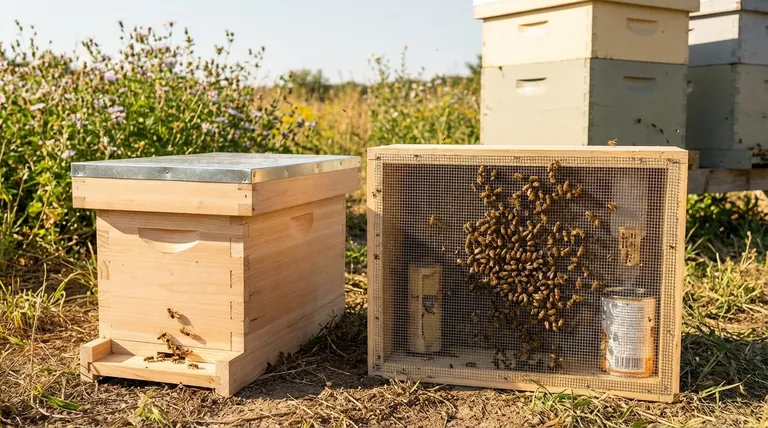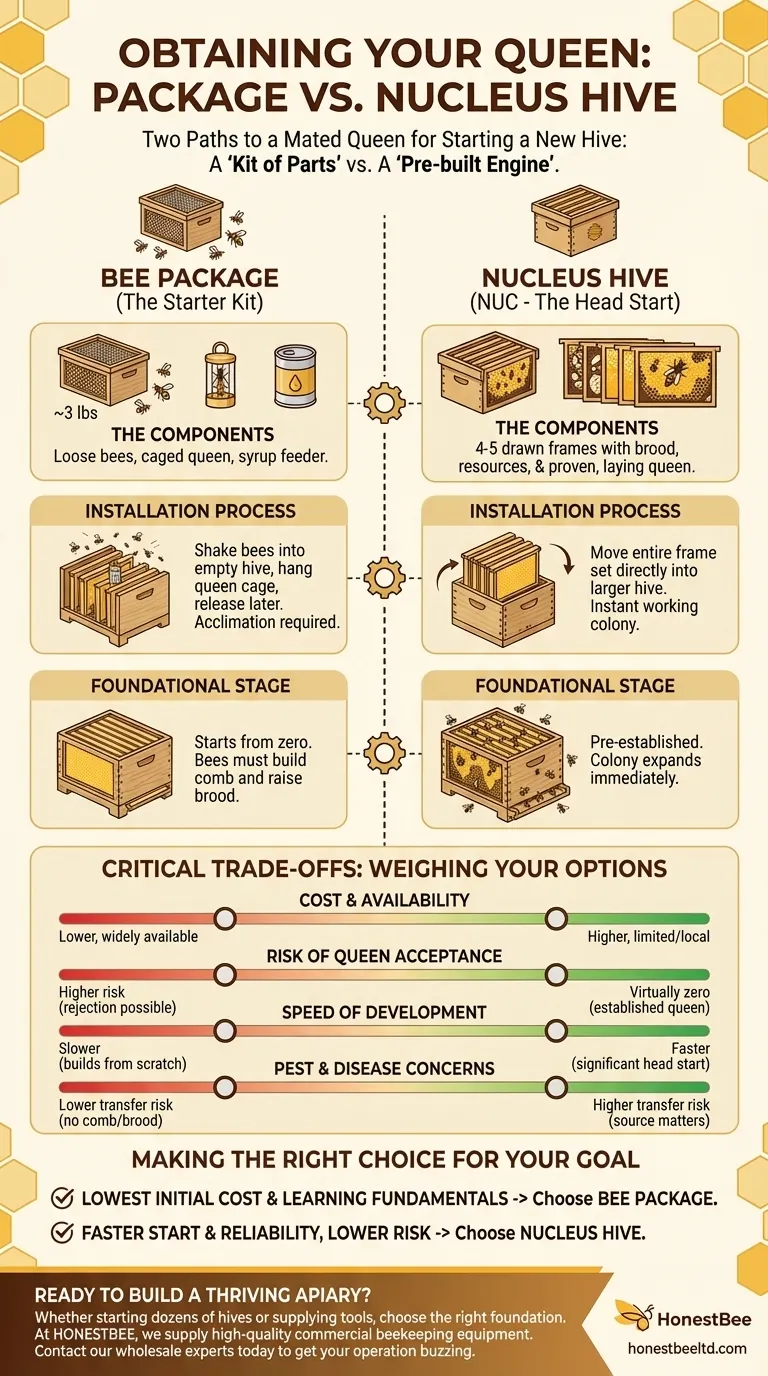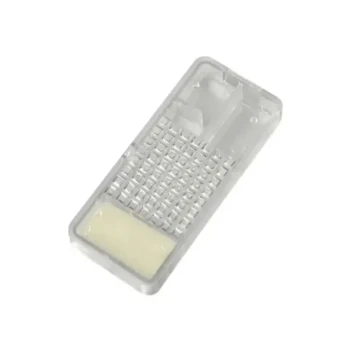When starting a new hive, the two primary ways to obtain a queen bee are by purchasing a bee package or a nucleus hive (nuc). Both of these options come with a mated queen included, but they represent two fundamentally different approaches to establishing a colony.
The core decision you face is choosing between a "kit of parts" and a "pre-built engine." A bee package provides the basic components—bees and a queen—while a nucleus hive gives you a small, functioning colony that is already working together.

Understanding the Bee Package
A bee package is essentially a starter kit for a colony. It's the most common way beekeepers acquire bees, especially at a larger scale.
The Components
A package consists of a screened box containing about two to three pounds of adult worker bees. It also includes a separate, small cage housing the queen and a can of sugar syrup to feed the bees during transport.
The Installation Process
You install a package by literally shaking the loose bees into your empty hive box. The queen, still in her cage, is then hung between two frames, allowing the colony to acclimate to her scent before she is released a few days later.
The Foundational Stage
With a package, the colony starts from zero. The bees have no comb, no brood, and no food stores. Their first critical jobs are to build wax comb, accept the new queen, and begin raising brood.
Understanding the Nucleus Hive (Nuc)
A nucleus hive, or "nuc," is a small, pre-established colony. It provides a significant head start compared to a package.
The Components
A nuc is typically sold in a small, self-contained box with four to five fully drawn frames. These frames contain everything needed for a functioning colony.
A Working Colony in a Box
Inside a nuc, you get a proven, laying queen, worker bees, and brood in all stages of development (eggs, larvae, and pupae). The frames will also contain stored resources like pollen and honey.
The Installation Process
Installation is simple and far less disruptive than with a package. You gently move the entire set of frames from the nuc box directly into your larger hive, maintaining their original order. The colony can then expand onto the new, empty frames you provide.
The Critical Trade-offs: Package vs. Nuc
Choosing between a package and a nuc involves weighing cost, risk, and speed. Neither choice is universally better; the right one depends on your goals and circumstances.
Cost and Availability
Packages are generally cheaper and more widely available from large-scale bee producers. Their lower cost makes them an economical choice for starting multiple hives. Nucs are more expensive and often sourced from local beekeepers, meaning availability can be limited.
Risk of Queen Acceptance
The greatest risk with a package is queen rejection. The bees are unrelated to the queen, and there is a small chance they will not accept her, causing the colony to fail. A nuc has an established, laying queen, so the risk of rejection is virtually zero.
Speed of Development
A nuc provides a significant head start. Because it already has drawn comb and an active brood cycle, a nuc colony will build up its population and begin foraging for nectar much faster. A package colony may take several weeks to catch up.
Pest and Disease Concerns
A package is less likely to transfer pests or diseases like Varroa mites or foulbrood because it does not include any comb or brood. A nuc carries the risk of inheriting any health issues present in the seller's apiary, making it crucial to buy from a reputable source.
Making the Right Choice for Your Goal
Your priorities as a new beekeeper will determine the best path forward.
- If your primary focus is the lowest initial cost and learning the fundamentals: A bee package is an excellent, foundational way to start a colony from the ground up.
- If your primary focus is a faster, more reliable start with a lower risk of failure: A nucleus hive is the superior choice for getting a colony established quickly and successfully.
Ultimately, both methods can lead to a thriving, productive hive when managed with care.
Summary Table:
| Feature | Bee Package | Nucleus Hive (Nuc) |
|---|---|---|
| Cost | Lower initial cost | Higher initial cost |
| Contents | Loose bees & a queen in a cage | 4-5 frames with bees, brood, food, & a laying queen |
| Risk | Risk of queen rejection | Virtually zero risk of queen rejection |
| Development Speed | Slower start (builds from zero) | Faster start (pre-established colony) |
| Best For | Budget-conscious beginners, large-scale starts | Reliability, faster honey production, lower risk |
Ready to build a thriving apiary?
Whether you're a commercial beekeeper starting dozens of hives or a distributor supplying the tools for success, choosing the right foundation is critical. At HONESTBEE, we supply the high-quality beekeeping supplies and equipment that commercial apiaries and distributors rely on.
Let us help you succeed from the very first frame. Contact our wholesale experts today to discuss your needs and get your operation buzzing.
Visual Guide

Related Products
- 5 Frame Wooden Nuc Box for Beekeeping
- Twin Queen Styrofoam Honey Bee Nucs Mating and Breeding Box
- Automatic Heat Preservation 6 Frame Pro Nuc Box for Honey Bee Queen Mating
- Plastic Transporting Bee Packages and Nuc Boxes for Beekeeping
- Portable Bee Mating Hive Boxes Mini Mating Nucs 8 Frames for Queen Rearing
People Also Ask
- What is the advantage of overwintering a nucleus? A Strategic Asset for Beekeeping Success
- What is the most common type of standard nuc? The 5-Frame Nuc Explained
- What are the benefits of using nucs for beginning beekeepers? Ensure a Successful First Hive with a Head Start
- What is a common feature of many 5-frame nuc boxes? The Integrated Feeder for Efficient Colony Growth
- What are the benefits of moving nuclei around the apiary? Master Strategic Hive Management



















